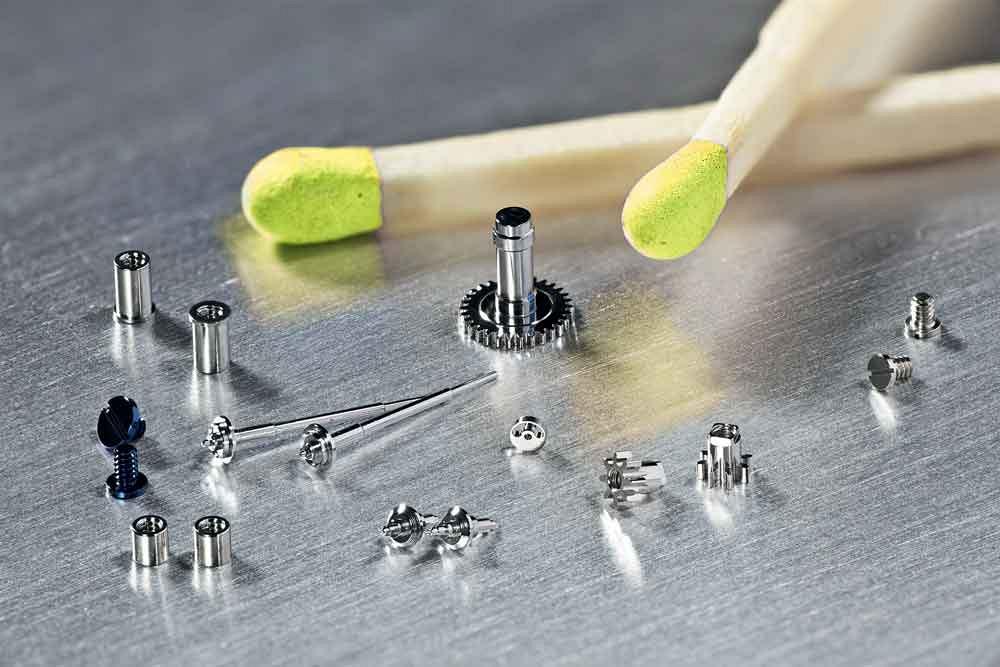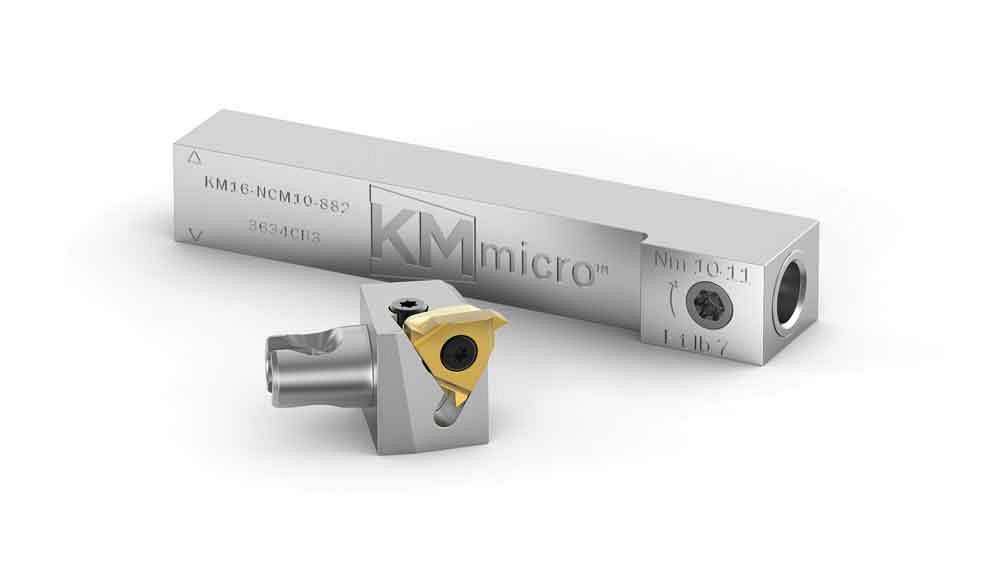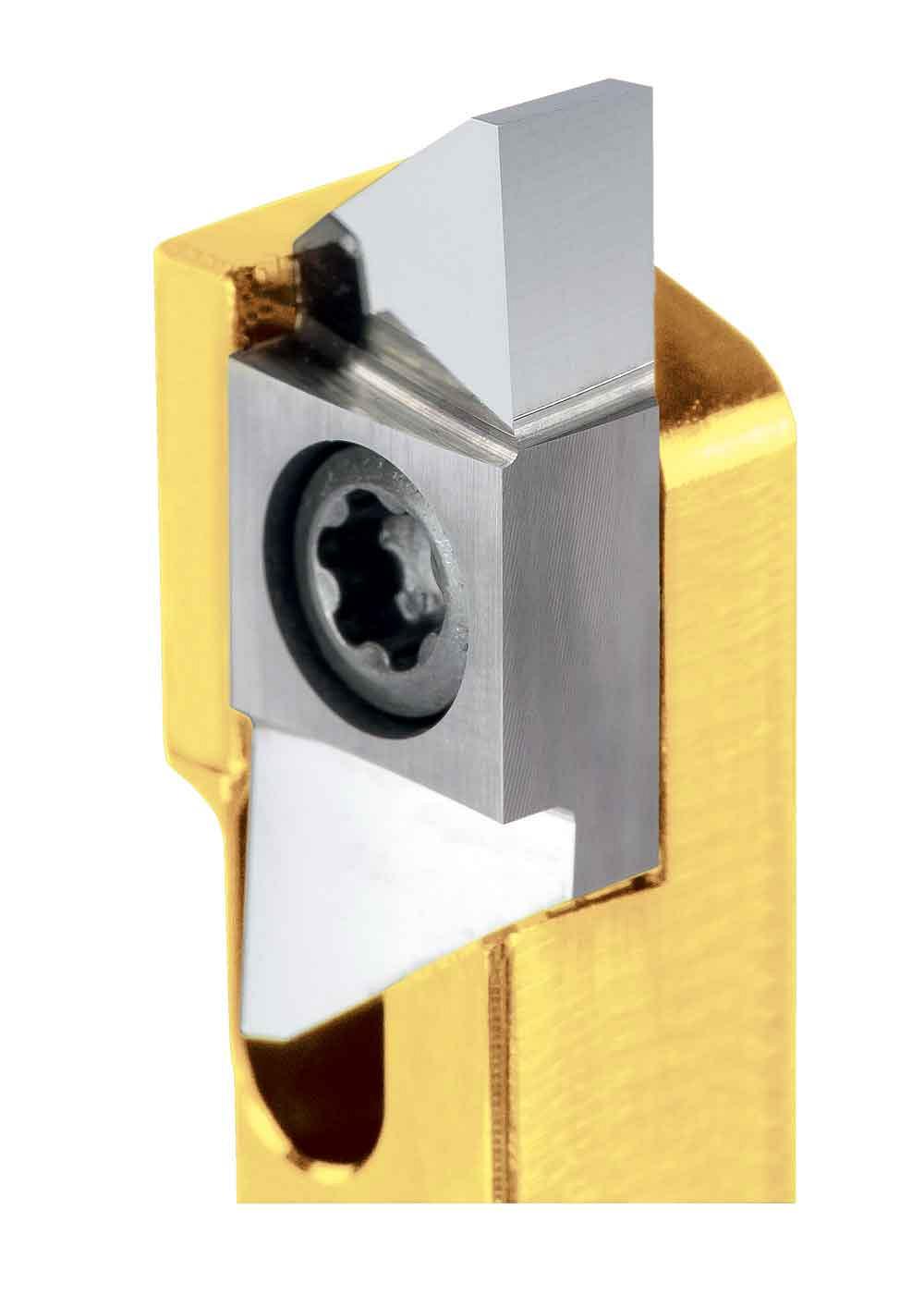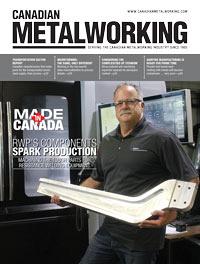- FMA
- The Fabricator
- FABTECH
- Canadian Metalworking
Microturning: The same, only different
Working in the microworld takes macroattention to process details
- By Sue Roberts
- November 28, 2016
- Article
- Cutting Tools

These small-diameter components were produced for the watch-making industry. Photo courtesy of Horn USA.
The size of parts that go into things like cellphones, high-end electronics, and medical and military equipment is continuously getting smaller as nearly everything in our world is being resized to fit in reduced spaces. In the aerospace and automotive industries, the constant goal of light-weighting is often accomplished by specifying smaller components. The result of these shrinking parts is an expanding micromachining industry.
“We certainly consider micromachining a growth market,” said Jay Verellen, director of global product management, tooling systems at Kennametal Inc. “It overlaps, and becomes a subsegment of, the small-parts machining market. Producing very small parts for in-body medical applications has been common, but now miniaturization is going across all the circuitry and electronics industries. I don’t think we can specify any industry that isn’t taking advantage of making things smaller.”
Best practices for turning components so small that several fit on the face of a dime mirror those of turning parts that are simply considered small, but additional attention needs to be given to some very specific areas of the microprocess.
“Before a manufacturer gets into micromachining, he needs to look at the whole process,” Verellen said. “In reality there are quite a few challenges. Machine utilization is critically important because part quantities can be low and handling the small inserts and tooling on the machine itself can be time-consuming because of their size and the machine configurations.
“One of the most practical problems is having access to and changing over inserts. There is typically very little room for an operator to rotate or replace an insert, particularly when using a Swiss machine producing parts that are only a few thousandths in size. The operator may need to remove the entire holder, change the insert, and spend time replacing and repositioning the holder in a very cramped space. The process can be awkward. There’s the time involvement and then there’s always a chance of dropping the small screws or the inserts themselves into the chip bin.
“Handling the tooling, usually with a shank size of ⅜ or ½ in., is more manageable because it is large enough to hold on to. The tools themselves are bigger than the components being machined.
“Once removed, the mating surfaces can be cleaned so a speck of material doesn’t interfere with the fit and add to the tolerance stack. And there is a little bit of a wedge design to securely lock the tool back in place.”
A quick-change system in which the entire cutting unit can be removed from the machine allows inserts to be changed or replaced where there is room to work and can speed the process by up to 60 per cent, according to Verellen.

Quick change tooling like KM Micro or KM Mini can reduce changeover downtime by up to 66 per cent, according to the company. Photo courtesy of Kennametal.
Tolerances are Microsized
The specified tolerance for repeatability shrinks along with the part’s size. In the microworld, tolerances are typically measured in microns--smaller than a human hair. Bill Redman, in global product management, tooling systems, for Kennametal, said, “In micromachining, a key is having a consistently low tolerance runout upon the tolerance stack. The pocket the insert goes into should be machine-ground, and the insert, whether it’s ground or pressed, should have a very tight tolerance specification.
“If repeatability is not there at setup after changing an insert, it can take quite a while to get that insert back to zero. You can imagine changing an insert, resuming production of microparts, and thinking that the new insert is in the exact place as the old one when it isn’t. If it’s cutting 0.0002 in. bigger or smaller, it can be a big problem. It can ruin the part.”
Tool breakage is also more of a concern in the microworld. Bob Kover, Tom Guzik, and Mike Smoody, a team of application and sales engineers at Horn USA, said that as in larger-part machining, a microtool should be as close to machine center as possible. In the microworld, however, any minor offset can cause a tool to snap.
The inserts are also more susceptible to damage. Their small, extremely sharp edges easily chip or break if they are dropped or collide with another hard surface. A chipped edge will negatively affect the cut quality and decrease tool life.
Machining at the wrong surface feet per minute (SFPM) can also be more of an issue when making microparts than when producing their larger counterparts. The Horn team said that with most machining processes, SFPM is maintained at a constant level, but as spindle RPMs increase as a small part gets even smaller, the machine’s RPM can max out and change the SFPM. This will decrease tool life and increase machine downtime for tooling replacement.
Tiny Chips Can Be Big Problems
Cutting small diameters at high RPMs can cause havoc with chip management. Chips that aren’t properly broken down can wrap around the tool. That leads to downtime to correct the problem and prevent damage to the insert, tool, and part.
“Whenever possible, choose an insert with a chipbreaker geometry, but it can be hard to add that kind of technology to very small inserts. Then you need to rely on the geometry of the tool itself and a precision insert edge,” said Verellen.

High-precision, indexable S274 tools are designed for machining small diameter bar stock. Photo courtesy of Horn USA.
Redman said, “High-pressure coolant is very popular in this industry, but our research has found that directional coolant can do a good job of moving the chips out of the way. Directing the coolant to a specific spot between the insert and the workpiece can create a hydrostatic wedge that maximizes the effectiveness of the insert’s geometry to move the chips out of the way.”
Some toolholders made for use in the compact spaces of microturning equipment have internal coolant supply features designed to flood the cutting area to remove chips.
Members of the Horn team said that in addition to incredibly sharp, clean, chip-free edges, maintaining the proper feed rate will help keep chip removal problems at bay.
Training Helps Transfer Skills
As with any manufacturing process, operators need to be trained in machine setup, cutting tool selection, and how to effectively apply the cutting tools.
“Once you show experienced machinists how micromachining is done, they can take their past experiences and build on them. There will be some habits and perceptions that need to be changed, and as with training for all new processes, there is a confidence level that needs to be established. It all goes back to providing the training and focusing on outcomes,” said Redman. “The technology to make correct microparts is here. The key for any shop is to make those parts profitably.”
Associate Editor Sue Roberts can be reached at sroberts@canadianmetalworking.com.
Horn USA, 615-771-4100, www.hornusa.com
Kennametal Inc., 800-446-7738, www.kennametal.com
About the Author

Sue Roberts
2135 Point Blvd
Elgin, IL 60123
815-227-8241
Sue Roberts, associate editor, contributes to both Canadian Metalworking and Canadian Fabricating & Welding. A metalworking industry veteran, she has contributed to marketing communications efforts and written B2B articles for the metal forming and fabricating, agriculture, food, financial, and regional tourism industries.
Roberts is a Northern Illinois University journalism graduate.
subscribe now


Keep up to date with the latest news, events, and technology for all things metal from our pair of monthly magazines written specifically for Canadian manufacturers!
Start Your Free Subscription- Industry Events
MME Winnipeg
- April 30, 2024
- Winnipeg, ON Canada
CTMA Economic Uncertainty: Helping You Navigate Windsor Seminar
- April 30, 2024
- Windsor, ON Canada
CTMA Economic Uncertainty: Helping You Navigate Kitchener Seminar
- May 2, 2024
- Kitchener, ON Canada
Automate 2024
- May 6 - 9, 2024
- Chicago, IL
ANCA Open House
- May 7 - 8, 2024
- Wixom, MI




















